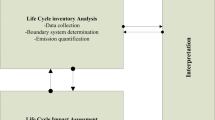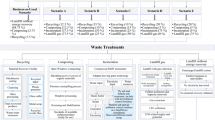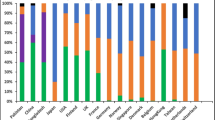Abstract
Municipal solid waste (MSW) is regarded to be an important source of greenhouse gas emissions, which could result in a significant impact on climate change. This study conducted analyses of both cumulative energy demand (CED) and carbon footprint (CF) indicators per reference flow (RF) and identified the relationship between both the indicators, and additionally, it made some recommendations for MSW management strategies in Pyongyang, DPR Korea, based on life cycle thinking. This present study suggested using a hybrid CED indicator and the energy-related CF indicator for the analysis of the existing MSW management system, while applying system expansion for crediting the recycled materials, the energy recovery, and the compost/fertilizer. The result showed that the CED indicator in the MSW management system accounted for − 9,569.8 MJ/RF of primary energy savings in total, corresponding to the avoided emissions of − 1,522.89 kg CO2eq/RF. The recycling and composting of waste presented energy savings due to the recycled materials and the avoided production of mineral fertilizers replaced with the compost, respectively. In addition, the incineration had some potential for energy recovery from waste, and it could result in crediting energy further, while the landfill should be improved in a more sustainable way of making use of the landfill gas and/or replacing the landfill with incineration with energy recovery. The results also indicated that the CED indicator was closely related to the CF indicator, valued as global warming potential, throughout the MSW management options/processes, and both the indicators could serve as an appropriate proxy of the environmental impacts on a life cycle phase.





Similar content being viewed by others
Data availability
All data generated or analysed during this study are included in this published article.
References
Beltran AM et al (2018) Quantified uncertainties in comparative life cycle assessment: what can be concluded. Environ Sci Technol 52:152–2161
Consonni S, Giugliano M, Massarutto A, Ragazzi M, Saccani C (2011) Material and energy recovery in integrated waste management systems: roject overview and main results. Waste Manag 31:2057–2065
Dehkordi SMMN, Jahromi ART, Ferdowsi A, Shumal M, Dehnavi A (2020) Investigation of biogas production potential from mechanical separated municipal solid waste as an approach for developing countries (case study: Isfahan-Iran). Renew Sust Energ Rev 119:109586. https://doi.org/10.1016/j.rser.2019.109586
Di Maria F, Sisani F, Contini S (2018) Are EU waste-to-energy technologies effective for exploiting the energy in bio-waste? Appl Energy 230:1557–1572
Ghinea C, Apostol LC, Prisacaru AE, Leahu A (2019) Development of a model for food waste composting. Environ Sci Pollut Res 26:4056–4069
Guo X, Yang X (2019) The economic and environmental benefits analysis for food waste anaerobic treatment: a case study in Beijing. Environ Sci Pollut Res 26:10374–10386
Haight M (2004) Technical report: integrated solid waste management model. School of Planning, University of Waterloo, Waterloo
Haynes RJ, Zhou YF (2016) Comparison of the chemical, physical and microbial properties of composts produced by conventional composting or vermicomposting using the same feedstocks. Environ Sci Pollut Res 23:10763–10772
Huijbregts MAJ, Rombouts LJA, Hellweg S, Frischknecht R, Hendriks AJ, van de Meent D, Ragas AMJ, Reijnders L, Struijs J (2006) Is cumulative fossil energy demand a useful indicator for the environmental performance of products? Environ Sci Technol 40:641–648
Huijbregts MAJ, Hellweg S, Frischknecht R, Hendriks HWM, Hungerbühler K, Hendriks AJ (2010) Cumulative Energy Demand as predictor for the environmental burden of commodity production. Environ Sci Technol 44:2189–2196
IPCC(Intergovernmental Panel on Climate Change) (2006) Guidelines for national greenhouse gas inventories, Prepared by the National Greenhouse Gas Inventories Programme, IGES, Japan
IPCC(Intergovernmental Panel on Climate Change) (2007) Climate change 2007: the physical science basis. In Contribution of Working Group 1 to the Fourth Assessment Report of the Intergovernmental Panel on Climate Change, Cambridge, New York: Cambridge University Press
ISO(International Standardization Organization) (2006) ISO 14044 International standard. In: Environmental Management–Life Cycle Assessment –Requirements and Guidelines. ISO, Geneva, CH
Kim CY et al (2009) A handbook for agricultural officials. The Agricultural Publishing (in Korean)
Laurent A, Olsen SI, Hauschild MZ (2012) Limitations of carbon footprint as indicator of environmental sustainability. Environ Sci Technol 46:4100–4108
Laurent A, Bakas I, Clavreul J, Bernstad A, Niero M, Gentil E, Hauschild MZ, Christensen TH (2014a) Review of LCA studies of solid waste management systems – part I: lessons learned and perspectives. Waste Manag 34:573–588
Laurent A, Clavreul J, Bernstad A, Bakas I, Niero M, Gentil E, Christensen TH, Hauschild MZ (2014b) Review of LCA studies of solid waste management systems – part II: methodological guidance for a better practice. Waste Manag 34:589–606
National Coordinating Committee for Environment (NCCE) (2012) DPR Korea’s second national communication on climate change, Pyongyang, http://www.unfccc.int/resource/docs/natc/prknc2.pdf. Accessed 20 May 2020
O NC, Pak HS, Sin YC, Ri YH, Kim YN (2018a) A feasibility study of energy recovery of RDF from municipal solid waste. Energy Sources A Recover Utilization Environ Effects 40:2914–2922
O NC, Kim WG, Kim KS (2018b) Assessment of environmental burdens for municipal solid waste management options. Waste Resour Manag 170:139–148
O NC, Pak HS, Om KC, Choe KH (2019) An evaluation of alternatives to energy recovery from municipal solid waste part 2: energy balance and carbon footprint. Energy Sources A Recover Utilization Environ Effects:1–12. https://doi.org/10.1080/15567036.2019.1670756
O NC, Hwang CJ, Ri PC, Kim CH (2020) Investigating effective waste–to-energy options from refuse-derived fuel resources. Energy.:1–10. https://doi.org/10.1680/jener.19.00074
OECD/IEA (2017) CO2 emissions from fuel combustion highlights, IEA. http://www.iea.org. Accessed 2 June 2019
OpenLCA (2016) GreenDelta. http://www.openlca.org. Accessed 12 July 2016
Pressley PN, Aziz TN, DeCarolis JF, Barlaz MA, He F, Li F, Damgaard A (2014) Municipal solid waste conversion to transportation fuels: a life-cycle estimation of global warming potential and energy consumption. J Clean Prod 70:145–153
Puig R, Fullana-i-Palmer P, Baquero G, Riba JR, Bala A (2013) A cumulative energy demand indicator (CED), life cycle based, for industrial waste management decision making. Waste Manag 33:2789–2797
Ribić B, Voća N, Ilakovac B (2017) Concept of sustainable waste management in the city of Zagreb: towards the implementation of circular economy approach. J Air Waste Manage Assoc 67:241–259
Sevigne-Itoiz E et al (2015) Methodology of supporting decision-making of waste management with material flow analysis (MFA) and consequential life cycle assessment (CLCA): case study of waste paper recycling. J Clean Prod 105:253–262
Sözer H, Sözen H (2019) Energy saving, global warming and waste recovery potential of retrofitting process for a district. J Clean Prod 238:117915. https://doi.org/10.1016/j.jclepro.2019.117915
Valente A, Iribarren D, Dufour J (2018) Harmonising the cumulative energy demand of renewable hydrogen for robust comparative life-cycle studies. J Clean Prod 175:384–393
VDI-Richtlinie VDI 4600 (1997) Kumulierter Energieaufwand (Cumulative Energy Demand). Begriffe, Definitionen, Berechnungsmethoden. deutsch und englisch. Verein Deutscher Ingenieure, VDI-Gesellschaft Energietechnik Richtlinienausschuss Kumulierter Energieaufwand, Düsseldorf
Wiedmann T, Minx J (2007) A definition of ‘carbon footprint’. Ecol Econ Res Trends 2:55–65
Yadav P, Samadder SR (2018) Environmental impact assessment of municipal solid waste management options using life cycle assessment: a case study. Environ Sci Pollut Res 25:838–854
Yousefi M, Khoramivafa M, Damghani AM (2017) Water footprint and carbon footprint of the energy consumption in sunflower agroecosystems. Environ Sci Pollut Res 24:19827–19821
Funding
This current study was supported by the Kim Il Sung University, including salaries, equipment, and supplies.
Author information
Authors and Affiliations
Contributions
Conceptualization: Nam-Chol O; methodology: Kon-Ho Kang; data collection: Song-Il Kim and Ryon-Hui Kim; analysis and investigation: Nam-Chol O and Chun-Hung Jo; writing of original draft and preparation: Ryon-Hui Kim and Nam-Chol O; writing of review and editing: Song-Il Kim.
Corresponding author
Ethics declarations
Competing interests
The authors declare that they have no competing interests.
Ethics approval and consent to participate
Not applicable
Consent for publication
Not applicable
Additional information
Responsible Editor: Philippe Loubet
Publisher’s note
Springer Nature remains neutral with regard to jurisdictional claims in published maps and institutional affiliations.
Rights and permissions
About this article
Cite this article
O, NC., Jo, CH., Kang, KH. et al. Life cycle–based, energy-related analysis for waste management strategies: a case study of two impact indicators in Pyongyang. Environ Sci Pollut Res 28, 13365–13374 (2021). https://doi.org/10.1007/s11356-020-11513-5
Received:
Accepted:
Published:
Issue Date:
DOI: https://doi.org/10.1007/s11356-020-11513-5




